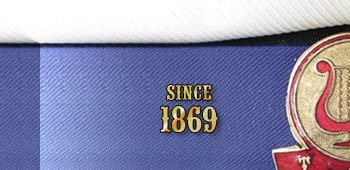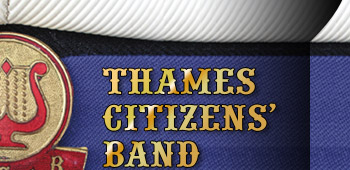THAMES MARCHING & CONCERT BAND HISTORY (2011) IN-BRIEF:
Back to the Official Thames Citizens’ Band History
All References in [ ]
Here is the brief (bullet listed) history of the Thames Marching Bands and their military Units from their official beginnings in 1869:
- 1833 First missionary station established for the area up “The Thames” (Waihou River) at Puriri (Anglican/Church of England); and also the first use of arranged music with instruments that could be found at the time. The station later moved to Hauraki (Thames) in 1837 (due to “extremely unhealthy” conditions in Puriri) and then the first Thames missionary house/station was built by Missionary James Preece (Church of England) in Kauaeranga (Parawai) near the intersection of the Herewaka Stream and what is now Parawai Road, Thames. St George's Anglican Church, Thames, grew out of this mission station; and the current St George's church building, cnr Mary and Mackay Streets, was completed in 1872, [01] the same year ‘St George's Naval Cadets’ were formed and named.
- 1863 During the NZ Land Wars, militia volunteers used ‘scratch bands’ (musicians pulled together for occasions) in the Waikato & Bay of Plenty. [02]
- 1867 The official proclamation of the Thames Goldfield by the Deputy-Superintendent of Auckland Province, Daniel Pollen, was made in July that year - this is the beginning of Thames Township. 1867-68 was the beginning of the “rush” to Thames for gold. [01]
- 1869 Three official “Volunteer” military
units formed in Thames this year, only two of which had marching bands.
These units were:[02, 03, 04, 05, 78]
- Thames Rifle Rangers
- Thames Naval Brigade & Fife & Drum Band (the very beginnings of Thames Citizens’ Band) (This unit has earlier roots as an off-shoot of the previously formed Auckland Naval Brigade) [84]
- Thames Scottish Volunteers & ‘Pipe’ Band
- 1872 Thames military units/bands were:
- Thames Rifle Rangers
- Thames Naval Brigade & Band
- St George's Naval Cadets (named and formed this year) [06, 15]
- Thames Scottish Volunteers & Band
- Thames Scottish Cadets (formed around this time) [07]
- 1874 · 1874 Thames Population estimated at
10,000, down on an earlier estimate of 18,000 in 1968. [08, 79] Thames
military units/bands were:
- Thames Rifle Rangers (est. 60 men) [08, 09, 11]
- No2 Hauraki Rifle Volunteers (started around this time) (est. 60 men) [08, 09, 14]
- No3 Hauraki Rifle Volunteers (started around this time) (est. 60 men) [08, 09]
- Thames Naval Brigade & Band (est. 120 men) [08]
- St George's Naval Cadets (est. 30 cadets) [08]
- Thames Scottish Volunteers & Band (est. 60 men) [08]
- Thames Scottish Cadets (est. 30 cadets) [08]
- 1875 Thames Military units/Bands were:
- Thames Rifle Rangers
- No2 Hauraki Rifle Volunteers
- No3 Hauraki Rifle Volunteers
- Native Contingent to Hauraki Rifle Volunteers (started 1875 with Rifle Range) [09,11]
- Thames Naval Brigade & Band (had new boat which seated 30 men - 40 x 6.5 feet, 2 masts & a jib with man-o-war gig. – Brigade raised money themselves) [08, 10]
- St George's Naval Cadets
- Hauraki Engineer Cadets (started 1875) [12, 14]
- Thames Scottish Volunteers & Band
- Thames Scottish Cadets
- 1877 Thames military units/bands were:
- Thames Rifle Rangers
- No1 Hauraki Rifle Volunteers
- No2 Hauraki Rifle Volunteers & Band (Fife & Drum Band started 1877) [04, 14]
- No3 Hauraki Rifle Volunteers
- Native Rifle Company (grew to Company with Rifle Range) [11, 16]
- Thames Naval Brigade & Band
- St George's Naval Cadets
- Hauraki Engineer Cadets
- Thames Scottish Volunteers & Band
- Thames Scottish Cadets
- 1878 Thames military units/bands were:
- Thames Rifle Rangers & Band (Band started 1878) [13, 16]
- No1 Hauraki Rifle Volunteers
- No2 Hauraki Rifle Volunteers & Band
- No3 Hauraki Rifle Volunteers
- Native Rifle Company - Above Rifle Companies were known as “Rifle Rangers” [16]
- Thames Naval Brigade & Band
- Thames Naval Artillery (Detachment and Guns) (Started 1878) [16]
- St Georges Naval Cadets
- Hauraki Engineers & Band (Band started 1878) [16]
- No1 Scottish Company & Band (Formerly Thames Scottish Volunteers & Band) [16]
- Thames Scottish Cadets
- 1879 Thames military units/bands were: [17]
- Thames Rifle Rangers & Band [17]
- No1 Hauraki Rifle Volunteers
- No2 Hauraki Rifle Volunteers & ‘Brass’ Band [17]
- No3 Hauraki Rifle Volunteers
- Native Rifle Company
- Thames Naval Brigade & ‘Brass’ Band (also had Fife & Drum Band) [17]
- Thames Naval Artillery
- St George's Naval Cadets
- Hauraki Engineers and ‘Brass’ Band (first uniformed parade 1879) [17]
- No1 Scottish Company & Band
- Thames Scottish Cadets
- 1882 Thames military units/bands were: [25, 81]
- Thames Rifle Rangers
- No1 Hauraki Rifle Volunteers
- No2 Hauraki Rifle Volunteers & Band
- No3 Hauraki Rifle Volunteers
- Native Rifle Company
- Thames Naval Brigade & Band
- Thames Naval Artillery
- Thames Naval Cadets (formerly St George's Naval Cadets) (by this year the Cadets had a smaller “man of war” boat with Cutters main and Jib sails, 10 oars, 23 x 6.5 feet, made of kauri timber) [18, 19]
- Hauraki Engineers & Band
- No1 Scottish Company/Cadets & Band (disbanded 1882 – members kept uniforms) [20, 80]
- 1883 Thames military units/bands after district
orders for volunteers changed December 1882 were: [21, 22]
- Thames Rifle Rangers
- Hauraki Rifle Volunteers & Band (reorganized No1, No2 & No 3 Hauraki Rifles 1883) [22]
- Thames Naval Artillery & Band (reorganized Naval Brigade/Cadets 1883) [22]
- Hauraki Engineers & Band (disbanded 1883 – 1884 court case to dispose of property and debts) [23, 24]
- 1884 Thames military units/bands were:
- Thames Rifle Rangers
- Hauraki Rifles & Band
- Thames Naval Artillery & Band
- Salvation Army Band (Started revival marches with band 1884) [26, 27]
- 1888 Thames Military units/Bands were:
- Thames Rifle Rangers (Disbanded 1888 – meetings to dispose of property and debts) [28,29]
- Hauraki Rifles & Band
- Thames Naval Artillery & Band
- Salvation Army Band
- 1891 Thames military units/bands were:
- Hauraki Rifle Volunteers
- Hauraki Brass Band (Rifles Band renamed & reorganised 1891) [30, 31]
- Thames Naval Artillery & Band
- Salvation Army Band
- 1898/99 Thames military units/bands at the beginning
of Boer War in South Africa were:
- Hauraki Rifle Volunteers (became company to the newly forming Hauraki Regiment with its headquarters in Paeroa). [32, 33, 34, 35]
- Hauraki Brass Band
- Thames Naval Artillery & Band
- Salvation Army Band
- 1900 Thames military units/bands during the Boer
War in South Africa were: [36]
- No1 Company Thames Rifle Volunteers (reorganized Thames Naval Artillery – NZ’s oldest and most efficient serving military formation. This brought the “Navals” into the new Regiment now named “No2 Battalion ‘Hauraki’ of Auckland Infantry Regiment”) [36,37,56]. The Thames Naval Brigade hung up their colours in St Georges Church [82]
- Hauraki Rifles.
- Hauraki Brass Band
- Thames Naval Band
- Salvation Army Band
- 1902 Thames military units/bands after the return
of the over 200 volunteers from the Boer War and a general restructuring
of the old Volunteer Forces were: [33]
- No1 Thames Rifles (headed up new Thames Defense Rifle Club) [36]
- Hauraki Rifles
- Hauraki Brass Band (the main cadet band of the battalion) [38, 39]
- No2 ‘Hauraki’ Battalion Band (elected/renamed Thames Naval Band) [38, 39]
- Salvation Army Band
- 1907 THAMES BAND CONTEST for all Upper North Island “A” Grade & “B” Grade Brass Bands was held at the Thames Race Course. The Hauraki Brass Band (Thames) won the quick step (over the Battalion Bands – surprisingly) and No2 Battalion Band (Thames) came second overall to the No1 Battalion Band (Auckland) [39]
- 1909 Thames military units/bands after the 1909
NZ Defence Act converting NZ’s 52 year old Volunteer Force to
a new NZ Territorial Force (including compulsory training for all males
aged 12 to 25): [40]
- 6th Hauraki Regiment of the NZ Territorial force, Auckland District, moved to new Headquarters in Paeroa (absorbing the No2 Battalion ‘Haurakis’) [40]
- 6th Hauraki Regimental Band (renamed No2 Hauraki Battalion Band) [41]
- Hauraki Brass Band
- Salvation Army Band
- 1914 Thames military units/bands as NZ went to war
against Imperial Germany and Austria-Hungary (W.W.I.) were: [43]
- Volunteers from Thames in the 6th Hauraki Regiment helped form the ‘Hauraki’ Company of the Auckland Regiment in the NZ Expeditionary Force in W.W.I. [43]
- 6th Hauraki Regimental Band
- Hauraki Brass Band
- Salvation Army Band
- 1923 Thames military units/bands were: [83]
- 6th Hauraki Regimental Band
- Hauraki Brass Band (disbanded 1923 – A big “smoke” concert held to celebrate) [83]
- Salvation Army Band
- 1930 The 6th Hauraki Regiment was presented their new colours at a Parade outside their Headquarters in Paeroa by the General Officer Commanding NZ Forces, Major General R. Young (these colours are now laid up in the Holy Trinity Church, 3rd Avenue, Tauranga). These colours, on a royal blue material, are a similar colour to the present (2011) Thames Citizens' Band Uniform. [44, 45]
- 1939 Thames military units/bands as Britain declared
war on Nazi Germany in September 1939 were:
- 6th Hauraki Regimental band (registered themselves as “Thames Citizens’ Band” March 1939 but continued to be known as 6th Hauraki Regimental Band while playing and for military ceremonies) [46, 47]
- Salvation Army Band
- 1941 Thames bands, as the NZ Second Expeditionary
Force was sent in 1941 to many different battles around the World in
W.W.II. [48], were:
- Thames Citizens’ Band (became officially known as this after formerly being 6th Hauraki Regimental band and also after the dispersal in 1941 of the 6th Hauraki Regiment's members throughout the ranks of the NZ Second Expeditionary Force sent overseas in W.W.II.) [48]
- Salvation Army Band
- In 1941 the Thames Citizens’ Band had their
outstanding debt over their instruments paid for, and the instruments
placed in trust by, the then Thames Borough Council, under Mayor S.
Ensore Esq. and the Borough Commissioner, Mr A. L. Burk; with the proviso
that should the Thames Citizens’ Band disband the instruments
were to go back to the “…Council for the future revival
of the band….” Thus the Thames Citizens’ Band at this
time effectively became a part of the Thames Borough Council.
(Minutes of Annual General Meeting, Thames Citizens’ Band, 22nd December 1941) [101]
- The Thames Citizens’ Band (TCB) has continued to operate as a citizens’ band in Thames from that time until the present day (2011).
- Note: In 1944 the remnant “Homeland” 1st Battalion of the 6th Hauraki Regiment was posted to garrison duty in Tauranga, Bay of Plenty (also a part of the Auckland Military district). The Battalion was finally revived again with the reorganisation of the N.Z. Military through the abolition of NZ Territorial Regiments in 1964, to become the ‘6th Battalion (Hauraki) RNZIR’ (Royal New Zealand Infantry Regiment) with its company and headquarters remaining in Tauranga. [49, 50]
- In 1981 TCB had continued to be a “Brass Band” as was the custom for military bands at the time but changed to a “Concert Band” with the inclusion of woodwind and some amplified instruments this year.[86] This boosted their waning membership and, it is believed, improved & modernised their sound.
- In 1997 the TCB purchased their current uniforms (2011).[139]
- In 2011 TCB Published their history (1869-2011)
With New Membership...Every new Member gets a copy of "Thames Citizens’ Band - Past Present Future" valued at $5.00 FREE as part of their membership. |
FREE
|


